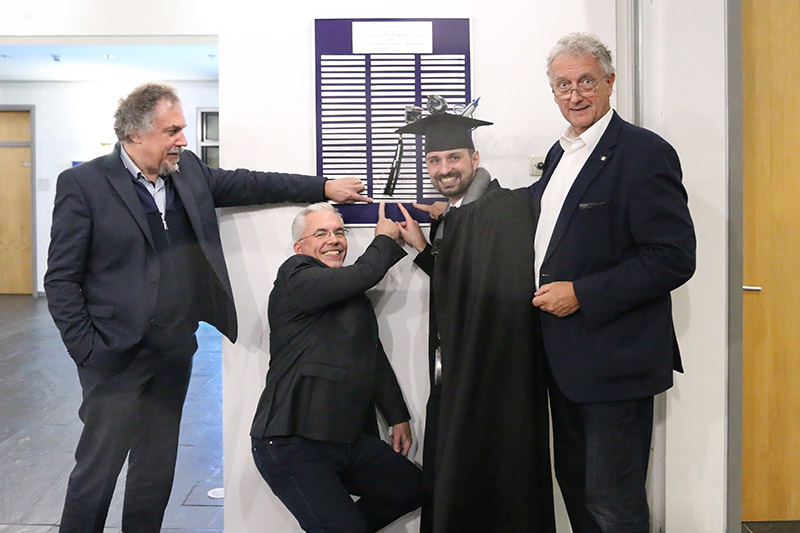Progressive Visual Analytics for Temporal Data
Promotion of Alex Ulmer
Congratulations on your doctorate! Alex Ulmer, researcher in the department of "Information Visualization and Visual Analytics", successfully defended his dissertation "Progressive Visual Analytics for Temporal Data". The thesis was supervised by Dr.-Ing. Jörn Kohlhammer (TU Darmstadt), Prof. Dr.-Ing. Dieter W. Fellner (TU Darmstadt/Fraunhofer IGD) und Dr. habil. Jean-Daniel Fekete (Université Paris-Saclay).
Abstract
Progressive visual analytics represents a relatively newly emerging research field, with the objective of accelerating the process of data analysis by computing intermediate results in a progressive manner. While the accuracy of the results improves over time, the sampling order can be steered by the user, thereby enabling the acquisition of valuable insights at an early stage, which in turn facilitates a more agile data analysis workflow. This thesis presents a novel taxonomy for progressive visualisations and a conceptual framework for the design of new web-based progressive visual analytics systems.
The time required for data processing, which serves as the foundation for providing an analyst with a visualisation, is dependent upon two primary factors:
1. The quantity of data that must be processed.
2. The degree of complexity of the processing algorithm.
Data collection is a ubiquitous practice across a multitude of domains, necessitating the ability to process substantial data repositories for a diverse array of users. Furthermore, more sophisticated algorithms are required to compute statistics, identify similarities or make predictions based on artificial intelligence. The current state of the art is that the majority of visual analytics systems are required to await the completion of computations before a visual representation can be displayed. It is common for analysts to wait for several hours for complex computations, such as simulations, to complete. Nevertheless, it is not always feasible to rely on increased computational power as a solution. Progressive visual analytics represents an approach whereby data or computation steps are segmented, thereby enabling the analyst to access intermediate results while the processing is still running in the background. The distinctive feature is that the user is able to interact with and respond to the results as they evolve. They can steer the computation by selecting regions of interest on which the processing algorithm should focus or modify parameters to adapt the progression based on early results. This enables the analyst to rapidly gain insights or intervene if the computation is not running as expected, thereby avoiding the loss of numerous hours.
This dissertation advocates the design of progressive visual analytics for web-based systems, establishing a novel taxonomy for the design of progressive visualisations and providing a technical concept for the implementation of such systems. The conceptual contribution of this thesis is the formulation of a new taxonomy for the research field. The concept of progressive visual analytics has been applied in other research areas under a variety of different names. Even within the field of visualisation, the progressive approaches were referred to by a number of different names, including incremental, fine-grain, and approximate visualisation. The concept of enhancing accuracy over time is not a novel one, having been applied in other research areas such as rendering and parallel processing. However, the distinctive and challenging aspect of progressive visual analytics is that the user is always able to interact with the system, and the results for data analytics are not precomputed. This necessitates the adaptation of visualisation techniques, which are addressed in the proposed taxonomy.
This dissertation presents a technical contribution in the form of a concept for the application of progressive visual analytics for temporal data in web-based systems. Temporal data is ubiquitous across all domains and is instrumental in analytical processes aimed at comprehending past phenomena and forecasting future trends. The data in question is frequently of a considerable magnitude, given that measurements may be taken at intervals as brief as one second, or that events may occur in even shorter fractions of a second. The progressive concept is beneficial in scenarios where the data is voluminous or the algorithms are slow, as well as in situations where computational resources are constrained, such as in mobile devices. The thesis proposes a concept for optimising the synergy between progressive computation and web-based visualisation for data analytics. The concept is evaluated with two case studies from the field of cybersecurity, in which communications are sent with nano-second precision, resulting in large data sources. The case studies demonstrated the benefits of progressive visual analytics for the cybersecurity domain and contributed to the refinement of the new taxonomy for progressive visualisations.
 Fraunhofer Institute for Computer Graphics Research IGD
Fraunhofer Institute for Computer Graphics Research IGD
